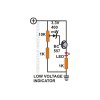sarathssca
New Member
Hello,
Could you please help in the construction of a solar charger. My solar panel is rated as 6V,3W and i am looking to charge a 6V,5AH lead acid battery. If i am directly connecting the solar panel to the battery its working (voltage of about 6V to 6.5V and current of about 175mA) . But if i am connecting a 6.8V zener diode in parallel to the battery for over charge protection , its not working.
I think when using zener diode in parallel to battery, all the power from the solar panel is is drained via zener diode and battery is not getting any power.
Is my understanding correct ?
Could you please help how to charge the battery with over charge protection or detection?
thanks
Sarath
Could you please help in the construction of a solar charger. My solar panel is rated as 6V,3W and i am looking to charge a 6V,5AH lead acid battery. If i am directly connecting the solar panel to the battery its working (voltage of about 6V to 6.5V and current of about 175mA) . But if i am connecting a 6.8V zener diode in parallel to the battery for over charge protection , its not working.
I think when using zener diode in parallel to battery, all the power from the solar panel is is drained via zener diode and battery is not getting any power.
Is my understanding correct ?
Could you please help how to charge the battery with over charge protection or detection?
thanks
Sarath


